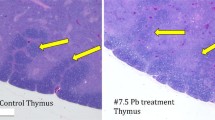Abstract
Adult ranch-bred mink (Mustela vison) were fed diets containing either 0, 1.0 μg/g polychlorinated biphenyls (PCB) (Aroclor® 1254), 1.0 μg/g methylmercury (MeHg), a combination of 1.0 μg/g PCB plus 1.0 μg/g MeHg, or 0.5 μg/g PCB plus 0.5 μg/g MeHg. Fertility of adult male mink, percentage of females whelped or number of kits born per female were not affected by the treatments. However, growth rate of kits nursed by mothers exposed to 1.0 μg/g PCB was significantly reduced. There was a synergistic effect of PCB and MeHg which reduced kit survival in groups receiving both chemicals simultaneously. Kit survival to weaning in the control, 0.5 μg/g PCB/MeHg, and 1.0 μg/g PCB/MeHg groups was 72.0%, 62.7% and 35.8%, respectively. The results suggest that growth and survival of mink kits are adversely affected at dietary levels of PCB and MeHg currently present in some environments.
Similar content being viewed by others
References
Aulerich RJ, Ringer RK (1977) Current status of PCB toxicity to mink, and effect on their reproduction. Arch Environ Contam Toxicol 6:279–292
Bleavins MR, Aulerich RJ, Ringer RK (1981) Placental and mammary transfer of polychlorinated and polybrominated biphenyls in the mink and ferret. Avian and Mammalian Wildlife Toxicology ASTM STP 757:121–131
— (1980) Polychlorinated biphenyls (Aroclors® 1016 and 1242): Effects on survival and reproduction in mink and ferrets. Arch Environ Contam Toxicol 9:627–635
Chanin PRF, Jefferies DJ (1978) The decline of the otter in Britain: An analysis of hunting records and discussion of causes. Biol J Linn Soc 10:305–328
Clark JR, De Vault D, Bowden RJ, Weishaar J (1984) Contaminant analysis of fillets from Great Lakes Coho salmon, 1980. J Great Lakes Res 10:38–48
Doull J, Klaassen C, Amdur M (1980) Toxicology, the basic science of poisons. 2nd ed, Macmillan, New York
Erlinge S (1972) The situation of the otter population in Sweden. Viltrevy 8:379–397
Foley RE, Jacklins SG, Sloan R, Brown M (1985) Comparison of organochlorine residue and heavy metal concentrations in wild mink and otter, with potential environmental sources. Abstract, Sixth Ann Meeting Soc Environ Toxicol Chem, St. Louis, MO, Nov. 10–13
Holcomb LC, Schaible PJ, Ringer RK (1962) The effects of varied lighting regimes on reproduction in mink. Bull Mich Agric Exp Sta 44:666–678
Hornshaw TC, Aulerich RJ, Johnson HE (1983) Feeding Great Lakes fish to mink: Effects on mink and accumulations and elimination of PCBs by mink. J Toxicol Environ Health 11:933–946
Macdonald SM, Mason CF (1982) The otterLutra lutra in central Portugal. Biol Conserv 22:207–215
Ministry of the Environment (1980) An inventory of mercury levels in Ontario fish, Appendum No. 2. Ontario Ministry of the Environment. Toronto, Canada
NRCC (1981) Workshop on the combined effects of xenobiotics. National Research Council Canada, No 18978, Ottawa, Canada
Platonow NS, Karstad LH (1973) Dietary effect of polychlorinated biphenyls on mink. Can J Comp Med 37:391–400
Vouk VB, Sheehan PJ (1983) Methods for assessing the effects of chemicals on reproductive functions. SCOPE 20, John Wiley and Sons, Toronto, Canada
Wren CD, Hunter DB, Leatherland JF, Stokes PM (1987) The effects of polychlorinated biphenyls and methylmercury, singly and in combination on mink. I: Uptake and toxic responses. Arch Environ Contam Toxicol 16:441–447
Author information
Authors and Affiliations
Rights and permissions
About this article
Cite this article
Wren, C.D., Hunter, D.B., Leatherland, J.F. et al. The effects of poly chlorinated biphenyls and methylmercury, singly and in combination on mink. II: Reproduction and kit development. Arch. Environ. Contam. Toxicol. 16, 449–454 (1987). https://doi.org/10.1007/BF01055266
Received:
Revised:
Issue Date:
DOI: https://doi.org/10.1007/BF01055266




